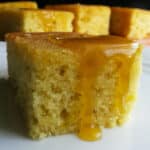Watch how to make the recipe
Ingredients
FOR THE CAKE
- 3 cups / 360g all purpose /cake flour
- 1 teaspoon baking powder
- ½ teaspoon baking soda / bicarbonate of soda
- ½ teaspoon salt
- 1 cup / 227g softened butter
- 1 ¼ cups / 250g sugar
- 4 eggs room temperature
- 1 teaspoon vanilla extract
- 1 cup / 250ml buttermilk SEE NOTE 1
FOR THE BUTTER SAUCE
- ¾ cup / 113g brown or white sugar SEE NOTE 2
- ½ cup / 115g butter
- ¼ cup / 60ml water
- 1 teaspoon vanilla extract
Instructions
To make the cake
- Combine the flour, baking soda (bicarbonate of soda) baking powder,½ and salt in a bowl.
- Using a stand mixer or handheld beater, beat the butter and sugar for about 3 to 5 minutes on medium-high speed until light and fluffy. SEE NOTE 3
- Add eggs, one at a time, beating after each addition. Beat in the vanilla extract.
- Add the flour mixture to the beaten butter and egg mixture.
- Beat for about 15 seconds then add in the buttermilk. Beat until just combined. Do not overbeat.
- Pour the mixture into a greased and lined square 9 inch (23cm) pan
- Bake in a preheated oven of 320°F (160°C) for 30 to 35 minutes until a toothpick inserted into the center comes out clean. SEE NOTE 4
- Remove the cake from the oven and let it cool in the tin for about 8 to 10 minutes before turning out onto a wire cooling rack.
To make the butter sauce
- Combine the water, sugar, butter, and vanilla extract in a pot.
- Cook on medium heat just until the butter is melted and the sugar has dissolved.
- You can either use the sauce immediately or allow it to cool and thicken for about 10 minutes before using it if you prefer.
Pour the sauce
- Place a cookie sheet or wax wrap under the cooling rack to catch any of the dripping sauce.
- Use the back of a skewer to poke holes in the cake. Pour the sauce over the warm cake. You can reserve about ¼ cup of sauce to use when serving if you prefer.
Recipe Notes
- If you do not have buttermilk, it is very easy to make your own. Simply add 1 ½ teaspoons of lemon juice or vinegar to 1 cup of milk. Set aside for 5 minutes to allow it to curdle before using
- You can use either white or brown sugar. I used brown sugar for the amazing caramel, butterscotch flavor it creates.
- Cream the butter and sugar well. The air integrated into the mix helps to leaven and create a lighter bake. Beat with an electric or stand mixer for between 3 to 5 minutes on medium-high speed.
- Do not overbake. This will cause a dry texture. Remove from the oven when you test with a skewer and see just a few crumbs clinging to it.
